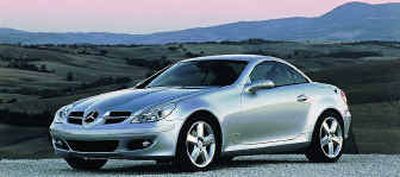Mercedes hits home run with SLK350

Mercedes-Benz has a lot to gain with its new SLK350 hardtop convertible and nothing much to lose.
The SLK was introduced in 1997, the first of a German trio of two-place sports cars that came to include BMW’s Z3 and the Porsche Boxster.
Audi came along later with its 2+2 TT, which also plays in this category.
The SLK sold well enough, but was ignored by enthusiasts, who preferred the sportier competition.
Shed no tears for M-B, though: the SLK found enough fans among high-achieving females to take the sting out of the rejection.
Clearly, there were voices at M-B that argued for taking the second-generation SLK to the next level, especially if it could happen without alienating the female fan base. The strategy worked: The new-for-‘05 SLK closes the performance gap, while maintaining M-B’s traditional virtues of comfort and luxury.
An all-new, 3.5-liter V-6 engine powers the SLK, which retains its elegant, folding hardtop and first-class cabin. The new engine sports double overhead camshafts — the first ever in a M-B six — and continuously variable valve timing. It produces 268 horsepower, a gain of 53, and 258 pound-feet of torque at 2,400 rpm.
Equipped with a new six-speed manual transmission, the SLK bests its competitors with a 0-60 mph sprint of 5.4 seconds. This gearbox is light-years ahead of the one it replaces, making short, quick and precise shifts. A seven-speed automatic, available for the first time on a six-cylinder M-B, is a $1,390 option.
The powertrain proved itself last fall on a beautiful drive down two-lane highways on both sides of the Columbia River Gorge and at the Portland International Raceway. Thanks to variable valve timing and a two-stage intake manifold, a tremendous amount of power is available at low rpm and the engine pulls strongly all the way to the 6,200-rpm redline.
Suspension tuning is far sharper than the original, without sacrificing ride quality, and Mercedes-Benz’s electronic stability control system is far less intrusive on the track. Instead of putting a check on the action at the first sign of traction loss, as it once did, the system now gives the rear end more leash, letting it slip into oversteer and not stepping in until things start to get out of hand.
“The system improves with each generation,” said M-B’s Jim Resnick.
The car is well balanced during high-speed turns and exhibits minimal body lean. Brakes are linear and strong and the steering system is precise and responsive, if a touch heavy and with a slightly artificial feel at center.
It’s not as crisp as the best of the competition but only a handful of drivers will notice or care.
If enthusiasts do react favorably to the SLK, it won’t be at the expense of their sybaritic impulses: The cabin is even more comfortable — and elegant — than that of the original, with firm, low-slung seats, a reasonable amount of storage space and a full array of comfort features.
As for the design, it’s familiar in that warm, techie way Mercedes has mastered of late, but it’s artful, too, with sleeker lines and lovely materials that provide high visual and tactile rewards.
Most noteworthy is a new item — an optional warm-air vent called AIRSCARF that’s embedded at neck-height in the front seatbacks. When bidden, it blows warm air on the back of the one’s neck. Sure, it’s decadent, but sports-car lovers everywhere are sighing in envy.
In deference to its sporting mission, M-B interior designers went easy on the wood trim; sticking with supple, fragrant leather and aluminum accents, they created a cockpit that’s beautiful and has a sense of mission.
Best, M-B continues to unwind COMAND, its previously indecipherable user interface, supplementing its single-screen functionality with old-fashioned buttons and labels.
The power hardtop operates with Swiss-watch precision, folding nimbly into the trunk. It’s unique in the class, works its magic in 22 seconds and soaks up less trunk space than before, thanks to a cleverly designed pivoting rear window.
With the top up, the SLK body becomes more rigid, a big advantage over soft-tops.
The SLK350 has a full complement of airbags, including side-impact head-and-thorax bags that deploy even with the top down. Rollover sensors tighten seatbelts and activate the side airbags.
Occupants’ noggins are protected by fixed roll hoops mounted behind the rear seats and reinforced A-pillars designed to hold their position.
On the outside, M-B worked hard to give the SLK350 an aggressive appearance that would appeal to men and achieved its goal with a front-end design reminiscent of the $450,000 Mercedes-Benz SLR McClaren supercar. The body flows rearward in a dramatic wedge shape and though the tail end may not be a work of art, neither does it let the team down.
Mercedes has introduced a new, scratch-resistant paint system this year. A nanotechnology process embeds ceramic particles into the molecular structure of the clearcoat, protecting its luster and toughening it up for parking-lot duty.
Now, if all this isn’t enough to bring you over to the M-B star, you might consider the over-the-top $61,000 SLK55 AMG. It rides an inch lower than the SLK350 and on 18-inch wheels. Its 5.5-liter V-8 makes 362 hp and 376 pound-feet of torque at 3,500 rpm.
There aren’t many players in this category; they’re all German and they’re all very good. With the introduction of the SLK350, Mercedes shows it’s serious about competing on all levels with the best of them. With not much to lose and everything to gain, they swung for the fences and hit one out of the park.